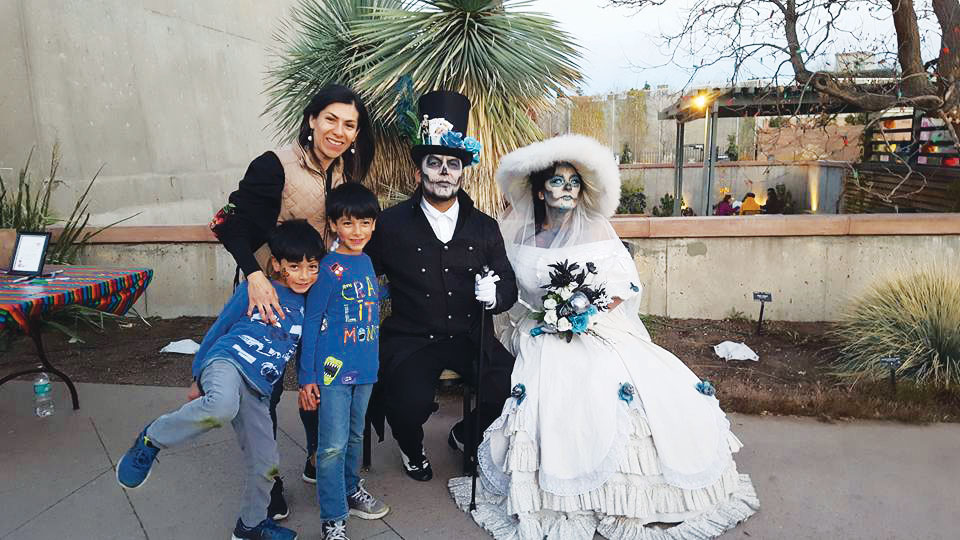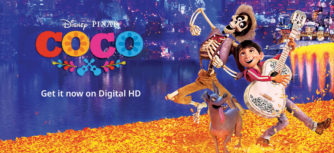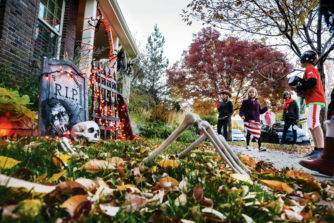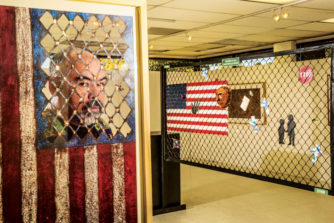
Teresa Mañago and her sons pose with costumed revelers at the Denver Botanic Gardens’
On October 31, as much of our community is trick-or-treating, some among us will be thinking of their departed loved ones and preparing to celebrate All Souls’ Day—the Day of the Dead.

Pixar’s Coco shared the lively holiday with a broad public.
The Pixar film “Coco” shared with a broad U.S. audience both the exuberance and the quiet faith of Día de los Muertos—Day of the Dead. This holiday, celebrated in central Mexico for centuries, was transplanted to the southwestern United States in the 1960s. The holiday demonstrates the migration and mingling of cultures and traditions, touching all the senses through food, art, faith, music, family and community. Though Day of the Dead, on November 2, almost coincides with Halloween, the two holidays have little in common beyond their initial origins.
A Brief History

A typical Halloween scene in Stapleton.
Like Halloween, Día de los Muertos traces its origins to pagan and Christian traditions. Believing that the veil between the here and the hereafter thins at the end of summer, the Celts each year had a festival marking the beginning of winter. They sought both to welcome and to appease the returning spirits by offering food and drink and wearing costumes to ward off malevolent spirits.
Centuries later, the Roman Catholic Church moved the days it honored martyrs and the faithful departed to November 1 and 2, perhaps hoping to discourage some of these popular practices. Día de los Muertos originates in these holy days—All Saints’ Day and All Souls’ Day—and even today centers on commemorating the dead. All Hallows’ Eve, the evening before All Saints’ Day, in contrast, has been stripped of its religious meaning in the U.S., resulting in the decidedly secular holiday of Halloween that fills our local streets with elaborate costumes and trick-or-treaters over-indulging in sweets.
All Soul’s Day not only honors the dead, but offers the living a way to help them. The Catholic belief in purgatory—a transitional place of purification—means that the prayers of the living can still benefit the dead. In European Catholic tradition, it was believed that the dead could briefly return to partake in food, bonfires, and other worldly enjoyments. Spanish documents from the fourteenth century mention offerings of bread and other items on graves during this period, and sweet breads in particular came to be associated with the holiday.
In Mexico, the holiday took on new meanings and forms. Though some writers ascribe Aztec origins to the holiday, others contend that the epidemic of Old World diseases, combined with the colonial sugar industry, were critical to shaping Mexico’s Day of the Dead. The enormous death toll in the colonial period heightened the importance of honoring the dead, and some communities made offerings of corn, blankets, food and chickens.

Last year, as a group of local moms of Mexican origin mourned the devastation wrought by the earthquake in Mexico City, their altar honored those who had died.
By the eighteenth century, people formed sugar paste into lambs and other shapes and gave them to children. Colorfully decorated figurines, coffins, and tombs appeared in Mexico’s markets, and people would keep vigil in the cemeteries after cleaning and decorating graves. These expressions of popular piety increasingly concerned authorities, who, by the late eighteenth century, sought a more “modern” vision of Mexico and tried unsuccessfully to limit the holiday’s excesses.
By the mid-twentieth century, the Mexican government embraced the holiday as a celebration of national pride, marketing it to middle class Mexican audiences and going so far as to bus senior citizens from urban areas to small towns to observe graveside vigils. This spread the holiday beyond traditional communities in Mexico.
Migration to the U.S.
Mexican emigres began bringing these traditions to the U.S. in the mid-twentieth century. Stapleton parent Teresa Mañago says that after coming to Denver from

Last year, Norberto Mojardin created several altars for Denver’s Mexican Cultural Center (MCC); here, he is pictured at his studio on East Colfax.
Mexico twelve years ago, the holiday took on an even deeper meaning for her, as it became “a way of connecting with my roots and sharing my culture with my family, and encouraging them to connect with their ancestors.” She recalls growing up in Coyoacán, the Mexico City neighborhood famous for the homes of artists Diego Rivera and Frida Kahlo. She joined family members decorating graves, praying and singing in the cemetery each year. At school and at home they made altars, and the church plaza of Coyoacán featured gorgeous artistic displays. Now she celebrates with other Stapleton moms of Mexican origin, building an altar for the Denver Botanic Gardens’ annual festivities.
For Denver artist Norberto Mojardin, owner of Beto’s Hair Studio on East Colfax, the holiday evokes memories of the grandmother who raised him. He describes growing up in Ortiz, Sonora, and after months of preparation, “I would wake up to a house full of hundreds of flowers. My grandmother made coronas of paper flowers for Día de los Muertos, and dipped them in wax so they kept their shape: wreaths, crosses, whatever people liked.” He would accompany her to the cemetery to clean and decorate the graves of family members with cempasúchil—large orange marigolds—favorite foods, beverages, and candles. People would sit through the night praying and keeping company by the grave. Mojardin says the holiday represents “a celebration of hope for a reunion” with one’s loved ones.
People often create home altars to honor deceased family members. These may include special foods like “pan de muerto” (literally “dead bread”) and sugar skulls, a dish of mole, and a favorite bottle of beer or liquor along with photos and keepsakes that belonged to the dead. These worldly temptations are meant to entice the spirits to briefly return and partake of their essence. Like the food and drink, the materials associated with the holiday are, like life itself, ephemeral: flowers, papel picado (thin paper cut in elaborate designs), and flimsy toys.
The Mexican Cultural Center this year will feature the work of Chihuahua-born Manuel Cordero, who says that in Cuauhtémoc where he grew up, the holiday centered only on cleaning and decorating the graves. “The holiday is very different in the north of Mexico…simpler and not as big,” he says. He is integrating his Day of the Dead piece with his existing exhibit at the MCC, “From South to North,” that offers a timely perspective on migration from both sides of the border.

Artist Manuel Cordero stands behind his installation at the Mexican Cultural Center (MCC).
Day of the Dead Events
The Denver area offers many options to participate in this colorful and meaningful holiday, which ultimately is, as Coco suggests, one of joyful remembering rather than sorrow: “The day you forget your loved ones is the day you should cry…not as long as you have them alive in your heart,” Mojardin says.
The Mexican Cultural Center, the Denver Botanic Gardens, and the Museo de las Americas are among the local sites where you can celebrate the Day of the Dead this year. Most events are free and open to the public unless otherwise indicated.
*See Day of the Dead events by clicking here: https://frontporchne.com/article/october-early-november-events/




0 Comments